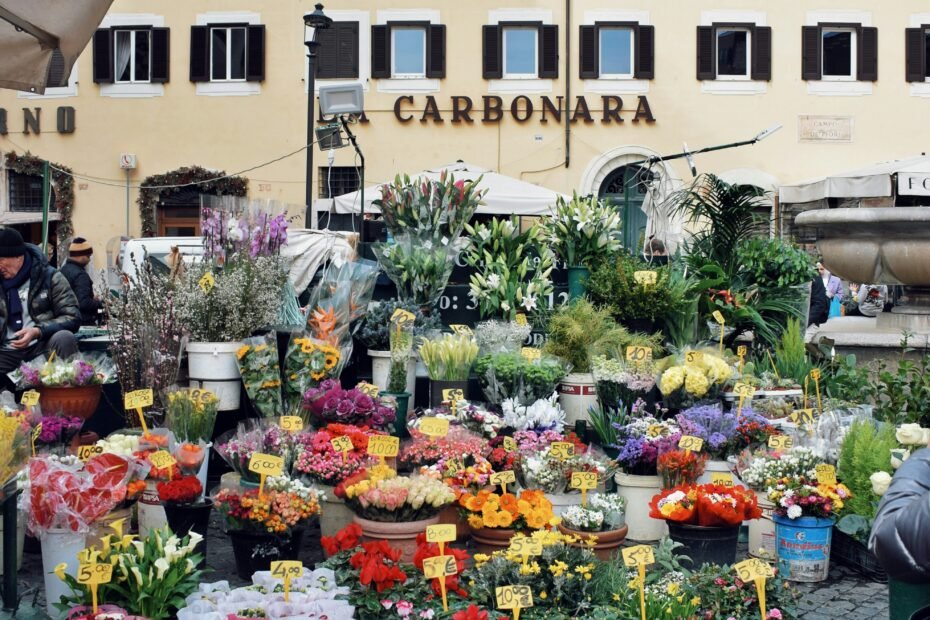Campo de Fiori, a vibrant and historic square in the heart of Rome, is a favorite destination for locals and tourists alike. Known for its lively atmosphere, bustling markets, and rich history, this piazza offers a unique blend of past and present. Here’s everything you need to know:
Historical Background
- Name Origin:
- Campo de’ Fiori means “Field of Flowers” in Italian, named after the wildflowers that grew in the area during the Middle Ages.
- Transformation:
- Originally an open meadow, it became a significant square in the 15th century when Pope Callixtus III ordered its development.
- A hub for commerce and social activity, it also witnessed darker events, including public executions.
- Giordano Bruno:
- The square is infamous as the site where philosopher Giordano Bruno was burned at the stake in 1600 for heresy. His statue now stands in the center of the piazza as a symbol of free thought.
What to See
- Giordano Bruno Statue:
- Erected in 1889 by Ettore Ferrari, this imposing bronze statue honors the philosopher and his fight for intellectual freedom.
- It’s a reminder of the square’s tumultuous history and a focal point for visitors.
- Market (Mercato di Campo de’ Fiori):
- Morning Market: One of Rome’s oldest markets, operating Monday through Saturday.
- What to Expect: Vendors selling fresh produce, flowers, spices, olive oil, cheese, meats, and souvenirs.
- Pro Tip: Arrive early to experience the market at its liveliest and sample local delicacies.
- Historic Palazzi:
- Palazzo della Cancelleria: A Renaissance palace nearby, home to a stunning courtyard and significant historical artifacts.
- Palazzo Farnese: Adjacent to the square, this impressive building now houses the French Embassy.
- Church of Santa Brigida:
- Located on the square, this 17th-century church was once the residence of Saint Bridget of Sweden.
Activities and Experiences
- Daytime Exploration:
- Wander through the market, shop for unique items, or simply enjoy the vibrant atmosphere.
- Evening Entertainment:
- The square transforms at night, with lively bars, restaurants, and street performers creating a festive ambiance.
- Dining:
- Enjoy authentic Roman cuisine at nearby restaurants, many with outdoor seating for people-watching.
- Photography:
- Capture the square’s lively market, historic buildings, and the dramatic statue of Giordano Bruno.
Practical Information
- Location:
- Situated in central Rome, near Piazza Navona and the Pantheon.
- How to Get There:
- Walk: A 10-minute walk from Piazza Navona or Largo di Torre Argentina.
- Public Transport: Bus routes stopping nearby include #64, #40, and others.
- Market Hours:
- Monday to Saturday, from early morning until early afternoon (around 2 PM).
- Best Times to Visit:
- Morning for the market and lively local activity.
- Evening for dining and nightlife.
Tips for Tourists
- Pickpocket Awareness:
- Like any busy area, keep an eye on your belongings, especially during the market.
- Try Local Delicacies:
- Look for vendors selling porchetta, fresh bread, and artisanal cheeses.
- Explore Nearby:
- Combine your visit with trips to Piazza Navona, the Pantheon, or Largo di Torre Argentina.
- Evening Drinks:
- Enjoy aperitivo (Italian happy hour) at one of the nearby bars for a quintessential Roman experience.
Nearby Attractions
- Piazza Navona:
- Just a short walk away, known for its fountains and Baroque architecture.
- Pantheon:
- A 10-15 minute walk, to one of Rome’s most iconic ancient landmarks.
- Largo di Torre Argentina:
- Famous for its ancient ruins and the spot where Julius Caesar was assassinated.
Fun Facts
- Campo de Fiori is unique among Roman squares as it lacks a church, focusing instead on its commercial and social functions.
- The square was a notorious execution site during the Roman Inquisition.
- The market has been a tradition since 1869, making it one of the city’s longest-running open-air markets.
Cultural Significance
Campo de’ Fiori reflects Rome’s dynamic spirit—a mix of historical gravity, local tradition, and modern vitality. Its market and nightlife offer a snapshot of Roman daily life, while its darker history is a reminder of the city’s complex past.
Conclusion
Whether you’re exploring the bustling market, dining at a cozy trattoria, or marveling at its historical landmarks, Campo de’ Fiori offers a unique and unforgettable experience. This lively square is a perfect blend of history, culture, and modern Roman life, making it a must-visit during your trip to the Eternal City.
